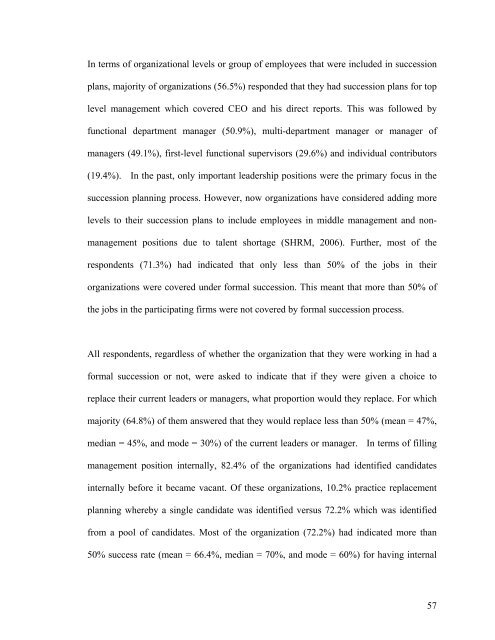CHAPTER 1: INTRODUCTION 1.0 Chapter Overview - DSpace@UM
CHAPTER 1: INTRODUCTION 1.0 Chapter Overview - DSpace@UM
CHAPTER 1: INTRODUCTION 1.0 Chapter Overview - DSpace@UM
You also want an ePaper? Increase the reach of your titles
YUMPU automatically turns print PDFs into web optimized ePapers that Google loves.
In terms of organizational levels or group of employees that were included in successionplans, majority of organizations (56.5%) responded that they had succession plans for toplevel management which covered CEO and his direct reports. This was followed byfunctional department manager (50.9%), multi-department manager or manager ofmanagers (49.1%), first-level functional supervisors (29.6%) and individual contributors(19.4%). In the past, only important leadership positions were the primary focus in thesuccession planning process. However, now organizations have considered adding morelevels to their succession plans to include employees in middle management and nonmanagementpositions due to talent shortage (SHRM, 2006). Further, most of therespondents (71.3%) had indicated that only less than 50% of the jobs in theirorganizations were covered under formal succession. This meant that more than 50% ofthe jobs in the participating firms were not covered by formal succession process.All respondents, regardless of whether the organization that they were working in had aformal succession or not, were asked to indicate that if they were given a choice toreplace their current leaders or managers, what proportion would they replace. For whichmajority (64.8%) of them answered that they would replace less than 50% (mean = 47%,median = 45%, and mode = 30%) of the current leaders or manager. In terms of fillingmanagement position internally, 82.4% of the organizations had identified candidatesinternally before it became vacant. Of these organizations, 10.2% practice replacementplanning whereby a single candidate was identified versus 72.2% which was identifiedfrom a pool of candidates. Most of the organization (72.2%) had indicated more than50% success rate (mean = 66.4%, median = 70%, and mode = 60%) for having internal57
















